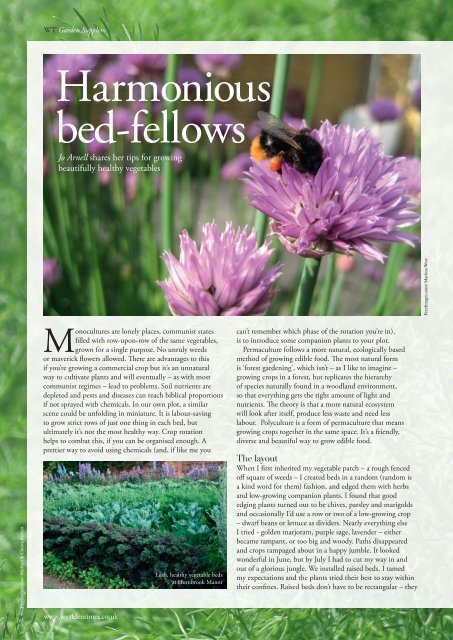Wealden Times | WT170 | April 2016 | Garden supplement inside
Wealden Times - The lifestyle magazine for the Weald
Wealden Times - The lifestyle magazine for the Weald
You also want an ePaper? Increase the reach of your titles
YUMPU automatically turns print PDFs into web optimized ePapers that Google loves.
WT <strong>Garden</strong> Supplement<br />
Harmonious<br />
bed-fellows<br />
Jo Arnell shares her tips for growing<br />
beautifully healthy vegetables<br />
FreeImages.com/ Michael & Christa Richert<br />
FreeImages.com/ Martina West<br />
Monocultures are lonely places, communist states<br />
filled with row-upon-row of the same vegetables,<br />
grown for a single purpose. No unruly weeds<br />
or maverick flowers allowed. There are advantages to this<br />
if you’re growing a commercial crop but it’s an unnatural<br />
way to cultivate plants and will eventually – as with most<br />
communist regimes – lead to problems. Soil nutrients are<br />
depleted and pests and diseases can reach biblical proportions<br />
if not sprayed with chemicals. In our own plot, a similar<br />
scene could be unfolding in miniature. It is labour-saving<br />
to grow strict rows of just one thing in each bed, but<br />
ultimately it’s not the most healthy way. Crop rotation<br />
helps to combat this, if you can be organised enough. A<br />
prettier way to avoid using chemicals (and, if like me you<br />
www.wealdentimes.co.uk<br />
Lush, healthy vegetable beds<br />
at Hornbrook Manor<br />
4<br />
can’t remember which phase of the rotation you’re in),<br />
is to introduce some companion plants to your plot.<br />
Permaculture follows a more natural, ecologically based<br />
method of growing edible food. The most natural form<br />
is ‘forest gardening’, which isn’t – as I like to imagine –<br />
growing crops in a forest, but replicates the hierarchy<br />
of species naturally found in a woodland environment,<br />
so that everything gets the right amount of light and<br />
nutrients. The theory is that a more natural ecosystem<br />
will look after itself, produce less waste and need less<br />
labour. Polyculture is a form of permaculture that means<br />
growing crops together in the same space. It’s a friendly,<br />
diverse and beautiful way to grow edible food.<br />
The layout<br />
When I first inherited my vegetable patch – a rough fenced<br />
off square of weeds – I created beds in a random (random is<br />
a kind word for them) fashion, and edged them with herbs<br />
and low-growing companion plants. I found that good<br />
edging plants turned out to be chives, parsley and marigolds<br />
and occasionally I’d use a row or two of a low-growing crop<br />
– dwarf beans or lettuce as dividers. Nearly everything else<br />
I tried - golden marjoram, purple sage, lavender – either<br />
became rampant, or too big and woody. Paths disappeared<br />
and crops rampaged about in a happy jumble. It looked<br />
wonderful in June, but by July I had to cut my way in and<br />
out of a glorious jungle. We installed raised beds, I tamed<br />
my expectations and the plants tried their best to stay within<br />
their confines. Raised beds don’t have to be rectangular – they<br />
06<strong>WT170</strong>Supplement.indd 4 23/03/<strong>2016</strong> 17:43


















